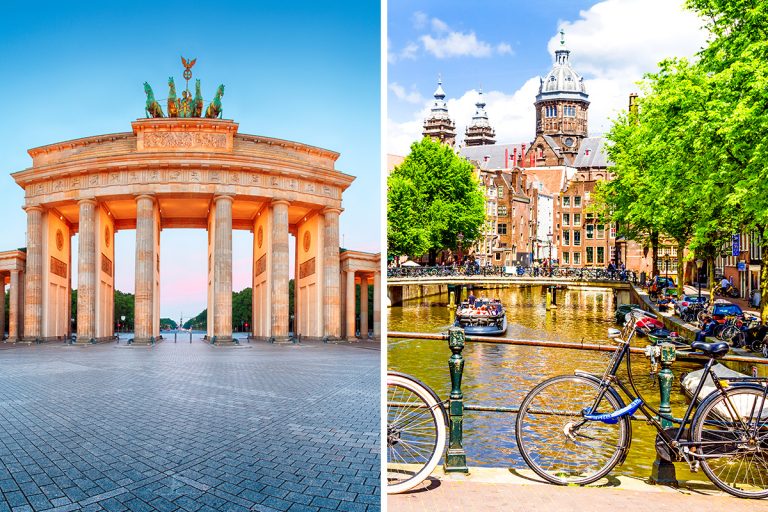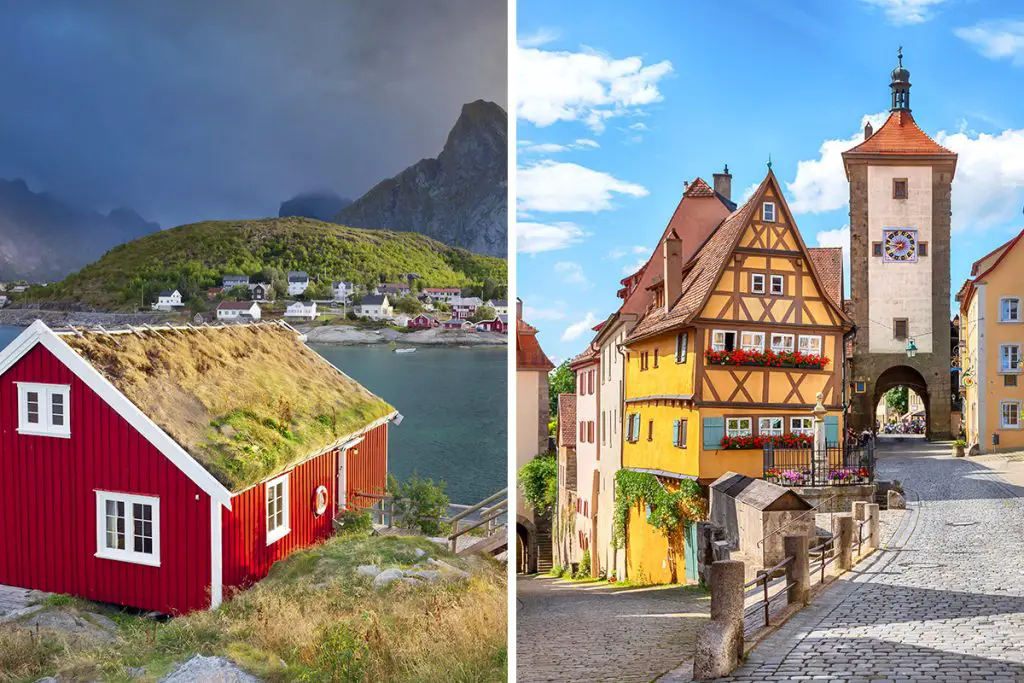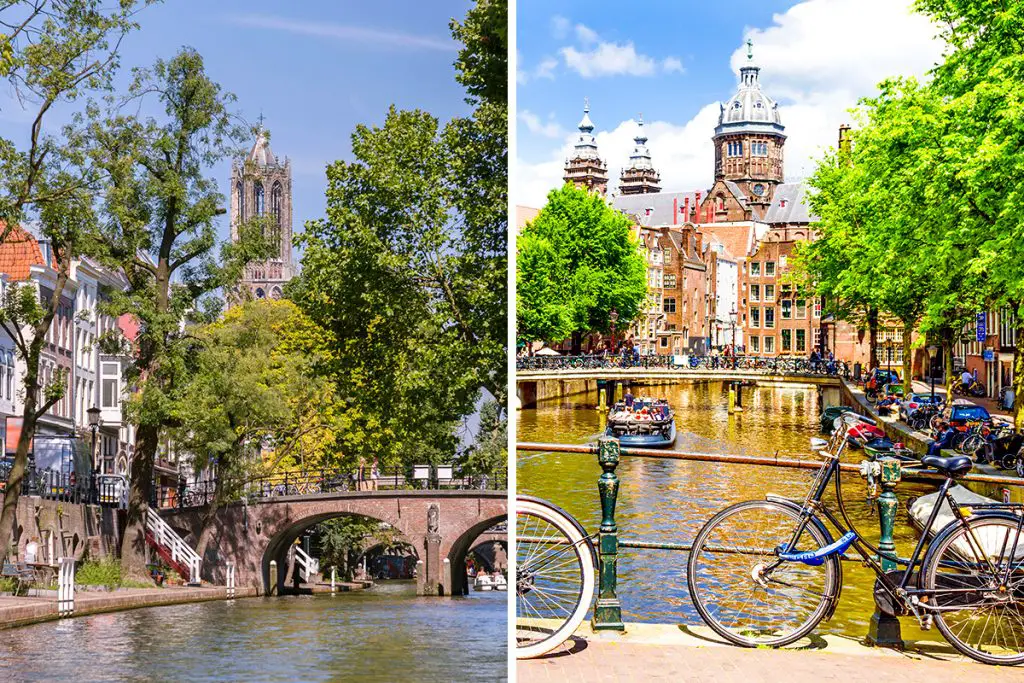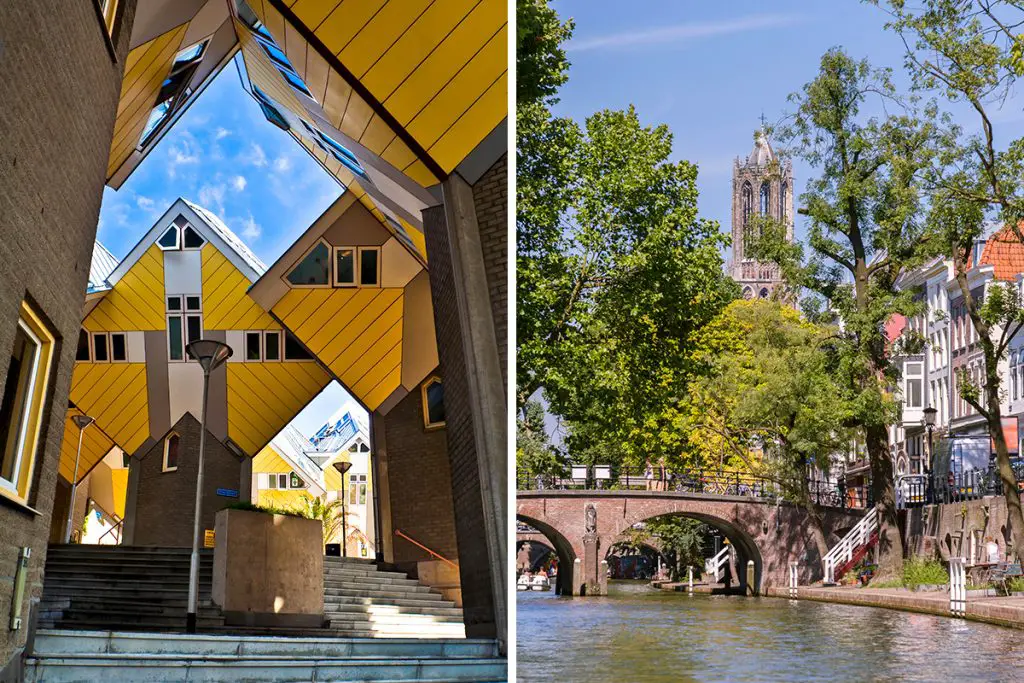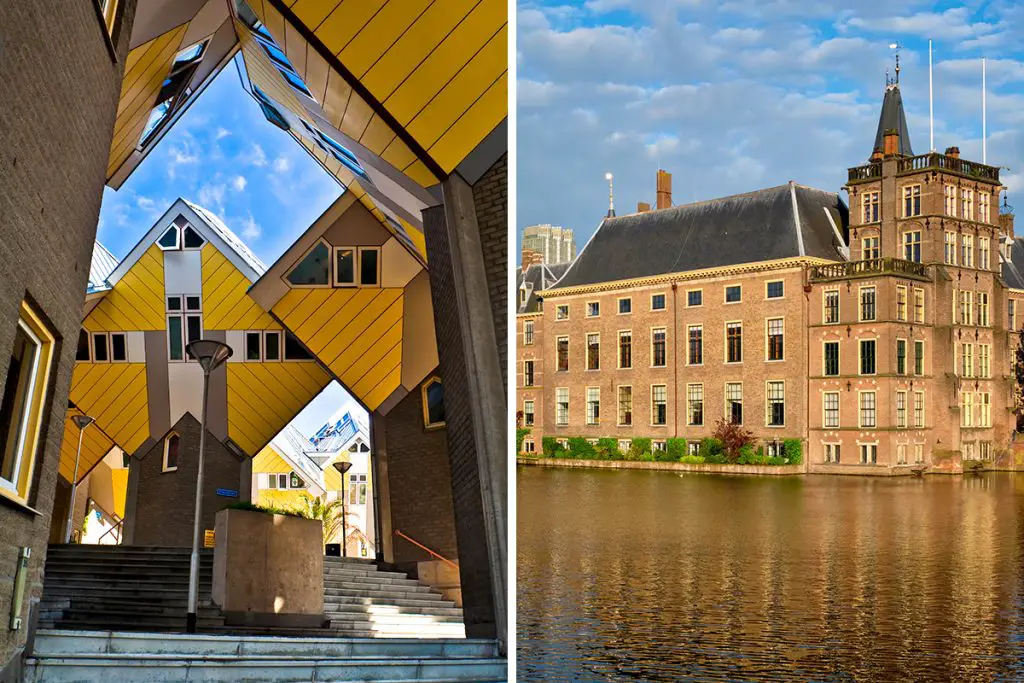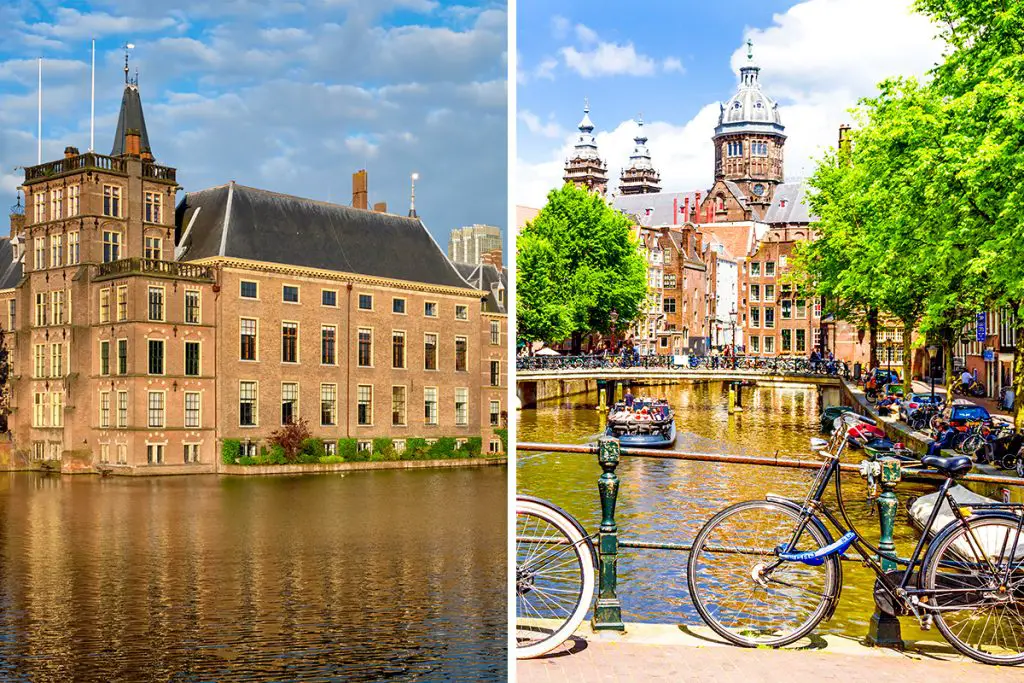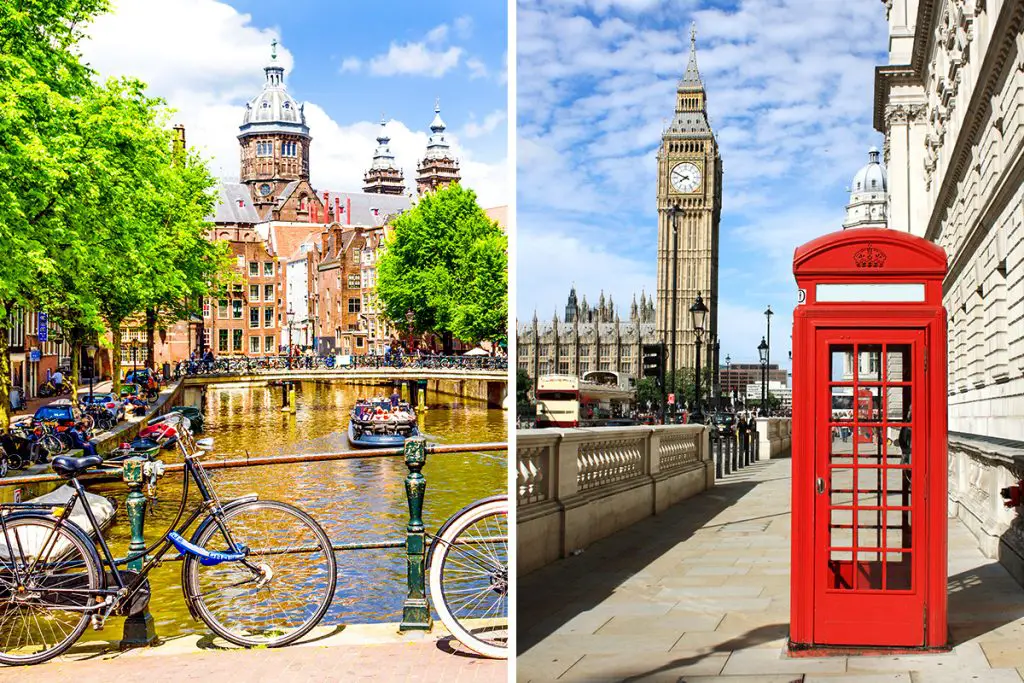Can’t make up your mind yet? Don’t worry. Dive deeper into what each city offers, and you might find that one resonates with your travel aspirations more than the other. So, shall we begin?
History & Culture
Both cities have rich and turbulent histories that shaped their cultures and identities.
Starting with Berlin, your journey into the past here is like turning the pages of a captivating history book. Berlin’s history is one of resilience and transformation. Once divided by the infamous Berlin Wall, the city now stands united, its iconic landmarks like Brandenburg Gate symbolizing freedom and unity.
Turning to Amsterdam, the city’s history is a story woven around its famous canals. Built during the Dutch Golden Age, Amsterdam flourished as a global trading hub. Its past is a rich tapestry of art, commerce, and discovery.
Culture in Berlin is as diverse as its history. The city is a hub for contemporary art and music, with numerous galleries and music venues scattered throughout. Its alternative scenes, like in the Kreuzberg district, are a testament to its spirit of innovation and freedom.
Amsterdam, too, is a cultural powerhouse. The city is renowned for its artistic heritage, home to world-famous museums like the Van Gogh Museum and Rijksmuseum. The spirit of creativity is alive in its numerous art galleries, music events, and theater performances.
Comparing the two, both Berlin and Amsterdam offer a rich blend of history and culture. While Berlin might appeal to you if you’re fascinated by modern history and alternative culture, Amsterdam might resonate more if you’re an art lover and enjoy picturesque cityscapes.
In conclusion, both cities offer a walk through time and a cultural feast. Whether you choose Berlin’s modern history and vibrant art scene or Amsterdam’s artistic heritage and charming canals, you’re in for a rich and enlightening experience.
Attractions & Activities
Both cities offer a variety of attractions and activities for different tastes and interests.
In Berlin, the attractions and activities that await you are a unique blend of historical and modern experiences. Begin your adventure at the Brandenburg Gate, a monumental landmark symbolizing unity and peace. Here, history surrounds you in grandeur. Next, visit the Berlin Wall Memorial to grasp the city’s divided past.
In Amsterdam, you’re set for a different kind of adventure. The city’s extensive canal system offers a unique way to explore. Take a canal cruise and marvel at the historic buildings and picturesque bridges. Don’t miss out on the Anne Frank House, a poignant tribute to the young girl’s courage during World War II.
Both cities also offer a natural retreat within their urban landscapes. In Berlin, the expansive Tiergarten offers a lush green escape right in the city center. It’s a perfect spot for a leisurely walk or a picnic. Over in Amsterdam, Vondelpark is the city’s most famous park, offering beautiful scenery and open-air concerts in summer.
For a taste of the extraordinary, Berlin’s famous ‘Museum Island’, a UNESCO World Heritage Site, is a must-visit. Five museums on this island offer a journey through centuries of art and culture. Meanwhile, in Amsterdam, the Rijksmuseum awaits you. This iconic museum houses Dutch masterpieces, including works by Rembrandt and Vermeer.
Summing up, both Berlin and Amsterdam offer diverse attractions and activities. If you’re drawn to historical landmarks and modern art, Berlin should be your pick. However, if canal cruises, poignant historical sites, and a rich artistic legacy appeal to you, Amsterdam is your place to be.
Eating, Drinking & Nightlife
Both cities have a lot to offer in terms of eating, drinking, and nightlife, but they have different styles and flavors.
In Berlin, the food scene is a smorgasbord of international and traditional German cuisine. You’ll find the famous Currywurst and Döner Kebab at street food stalls. For a more refined dining experience, Berlin’s upscale restaurants offer an array of global dishes.
Amsterdam, on the other hand, is a city where you can sample traditional Dutch fare. From Haring (raw herring) to Stroopwafels (caramel-filled waffles), Amsterdam’s food culture is a delightful experience for your taste buds.
When it comes to drinks, Berlin’s craft beer scene is buzzing with creativity. Breweries like BRLO have added a modern twist to the traditional German beer culture. In Amsterdam, you’re in the land of Heineken. But that’s not all. Jenever, a traditional Dutch gin, is another must-try when you’re in the city.
The nightlife in Berlin is legendary, with a reputation as one of the best party cities in Europe. Whether it’s techno clubs like Berghain or jazz venues like Quasimodo, Berlin’s night scene is diverse and vibrant. Amsterdam also boasts a lively nightlife, with its famous brown cafes, trendy clubs in Rembrandtplein, and music venues like Paradiso.
In conclusion, whether you’re a food lover, a drink enthusiast, or a night owl, both Berlin and Amsterdam have plenty to offer. Berlin stands out for its international cuisine, craft beers, and electrifying nightlife. Amsterdam shines with its traditional Dutch food, iconic beverages, and diverse night scene.
Shopping
Both cities have plenty of shopping opportunities that cater to different budgets and preferences.
In Berlin, shopping ranges from trendy boutiques in Mitte to second-hand shops in Kreuzberg. Kurfürstendamm, known as ‘Ku’damm’, is the city’s most famous shopping street, lined with both luxury brands and high-street fashion.
Amsterdam offers a different shopping experience. The city’s Nine Streets (‘De Negen Straatjes’) district is a haven for boutique shopping, offering everything from designer labels to unique antiques. For luxury shopping, head to P.C. Hooftstraat, where you’ll find high-end international fashion brands.
Both cities also have vibrant markets. In Berlin, the Mauerpark Flea Market is a Sunday favorite, selling everything from vintage clothing to handmade jewelry. Amsterdam’s Albert Cuyp Market, the largest daytime market in Europe, is a must-visit for its wide variety of goods and food stalls.
To sum it up, both Berlin and Amsterdam offer a mix of luxury, high-street, and boutique shopping, along with lively markets. Berlin’s shopping scene leans towards the trendy and eclectic, while Amsterdam offers a blend of boutique shopping and traditional market experience.
Accommodation
Amsterdam and Berlin offer a wide range of accommodation options, one is pricier and more crowded, while the other is cheaper and more spacious, but may lack some charm or convenience.
When you’re planning your stay in Berlin, you’ll find a range of accommodations to suit your preferences. Whether it’s luxury hotels in Mitte, trendy hostels in Kreuzberg, or cozy vacation rentals in Prenzlauer Berg, Berlin has it all.
On the other hand, Amsterdam offers charming canal houses turned into hotels, modern hostels, and vacation rentals in the heart of the city. From the luxurious Amstel Hotel to the budget-friendly Flying Pig Downtown, Amsterdam has a variety of options.
In Berlin, budget accommodations like hostels and budget hotels are plentiful. Mid-range hotels offer a balance between comfort and cost, while luxury hotels like the Hotel Adlon Kempinski offer top-of-the-line amenities.
In Amsterdam, budget travelers can find hostels and budget hotels, while mid-range accommodations offer more amenities. Luxury seekers can stay in 5-star canal houses turned hotels, offering a unique Amsterdam experience.
In conclusion, both Berlin and Amsterdam offer a wide range of accommodations to fit different budgets and tastes. Berlin stands out with its variety of trendy accommodations, while Amsterdam offers the unique experience of staying in a canal house.
Family-Friendliness & Children’s Activities
Amsterdam and Berlin are both suitable for families, with many parks, playgrounds, and museums that cater to children.
Berlin is a city that knows how to cater to families. With its numerous parks, like the Tiergarten and the famous Berlin Zoo, your family will have plenty of space to play and explore. Museums like the Museum of Natural History and the Labyrinth Children’s Museum are also great for kids.
Amsterdam is also family-friendly, with its Vondelpark, Artis Zoo, and the NEMO Science Museum being a big hit among the little ones. The city’s flat landscape also makes it perfect for family bike rides.
Both cities offer a range of family-friendly accommodations. In Berlin, many hotels and vacation rentals cater to families. Similarly, Amsterdam offers family rooms in hotels and spacious vacation rentals.
To sum up, both Berlin and Amsterdam shine when it comes to family-friendliness and children’s activities. Berlin’s wide green spaces and kid-friendly museums make it a great choice, while Amsterdam’s bike-friendly nature and interactive museums will surely keep the kids entertained.
Getting There & Getting Around
Amsterdam and Berlin are well connected by various modes of transportation, but one is closer and easier to reach from most European destinations.
Getting to Berlin is easy, with the Berlin Brandenburg Airport serving as the main international gateway. From the airport, it’s about 18 miles (29 kilometers) to the city center.
Amsterdam’s Schiphol Airport is one of the busiest in Europe. The airport is conveniently located just 9 miles (14 kilometers) from the city center.
Once you’re in Berlin, you can use the efficient public transportation system, which includes the U-Bahn (subway), S-Bahn (overground train), buses, and trams. Renting a bike is also a popular option.
In Amsterdam, you’ll find that the city is compact and easy to navigate. The public transportation includes trams, buses, and ferries. Of course, Amsterdam is famous for its cycling culture, so renting a bike is a great way to explore the city.
To conclude, both Berlin and Amsterdam have efficient public transportation systems and are bike-friendly cities. Berlin’s extensive public transportation system makes it easy to explore, while Amsterdam’s compact size and cycling culture offer a unique experience.
Weather
When planning a trip, the weather plays a big part in your decision.
In Berlin, the climate is temperate, meaning it has four distinct seasons. In the winter, Berlin can get quite cold, with temperatures dropping to 32°F (0°C). Summers, on the other hand, are warm and pleasant, with highs around 77°F (25°C).
Amsterdam, too, experiences a temperate maritime climate. However, due to its proximity to the sea, the city’s weather can be quite changeable.
Winters in Amsterdam can be mild, with temperatures hovering around 37°F (3°C). Summers are generally not too hot, with temperatures peaking around 72°F (22°C).
In conclusion, both Berlin and Amsterdam have a temperate climate, with Berlin experiencing colder winters and warmer summers. Amsterdam’s climate is milder, but the weather can change quickly, so always be prepared.
Safety
Safety is another crucial factor when choosing a travel destination. Both Berlin and Amsterdam are generally considered safe cities, but there are differences to note.
In Berlin, like any large city, petty crime such as pickpocketing can occur, especially in crowded tourist areas. However, serious crimes are relatively low.
In Amsterdam, the situation is similar. Petty crimes like pickpocketing or bike theft are common, but violent crimes are rare. It’s always recommended to be aware of your surroundings, especially in crowded places.
Aside from crime, both cities have excellent healthcare systems. If you need medical attention while in Berlin or Amsterdam, rest assured that you will receive high-quality care.
To sum up, both Berlin and Amsterdam are generally safe cities with low rates of serious crime. As in any city, remain vigilant and take basic precautions to ensure a worry-free trip. Both cities also provide excellent healthcare, adding to your safety while traveling.
Cost
When planning a trip, cost is a factor that you’ll definitely want to consider.
In Berlin, you’ll find that the cost of living is relatively affordable. Eating out in Berlin can cost around 10 Euros ($11) for a basic meal. For public transportation, a one-way ticket is about 2.80 Euros ($3).
Now, let’s consider Amsterdam. The cost of living here is a bit higher. A basic meal can cost around 15 Euros ($17) and public transportation is about 3 Euros ($3.40) for a one-way ticket.
Accommodation also differs. In Berlin, a mid-range hotel can cost around 80 Euros ($90) per night. In Amsterdam, similar accommodation can cost around 120 Euros ($135) per night.
In summary, Berlin is generally more affordable than Amsterdam. Whether it’s food, transportation, or accommodation, you’ll likely spend less in Berlin. However, Amsterdam, while more expensive, offers its own unique charm and experiences which might justify the extra cost.
Which Is Better – Berlin or Amsterdam?
After considering various factors, it’s clear that both Berlin and Amsterdam offer unique experiences.
When it comes to history and culture, both cities have a rich past, yet Berlin’s historical landmarks and diverse culture might appeal to history buffs. For those seeking more active experiences, Amsterdam, with its myriad of unique attractions and activities, might be a better choice.
If food, drink, and nightlife are important to you, both cities will satisfy, but Amsterdam’s unique canal-side dining and vibrant nightlife are truly unforgettable experiences.
Shopping is delightful in both cities, but Berlin’s trendy boutiques and artsy shops might appeal to you if you’re seeking something different. For family-friendly experiences, both cities shine, but Amsterdam’s wealth of family-oriented activities might edge it out slightly.
In terms of getting around, both cities have excellent public transportation systems, but Amsterdam’s extensive bike culture offers a unique, active, and eco-friendly way to explore.
When it comes to weather, Berlin’s colder winters and warmer summers contrast with Amsterdam’s milder, yet more changeable climate. Safety-wise, both cities are relatively safe with low rates of serious crime, but like in any city, it’s always important to take basic precautions.
Finally, regarding cost, Berlin is generally more affordable than Amsterdam. However, if budget is not your primary concern, the unique charm and experiences that Amsterdam offers could justify the extra cost.
In conclusion, your choice between Berlin and Amsterdam will depend on what you value most in your travel experience. Whether it’s history, culture, activities, food, or cost, both cities have their own strengths, and either would make for a memorable trip. The key is to choose the one that best aligns with your personal travel preferences.

